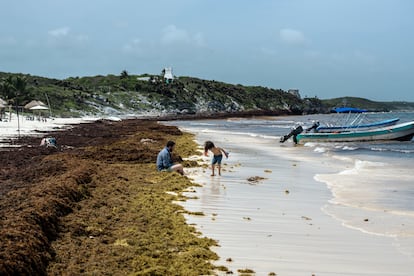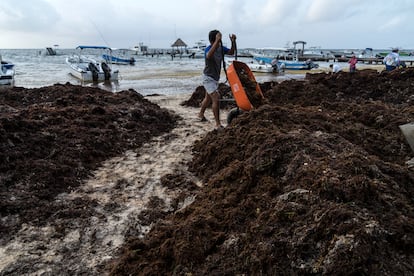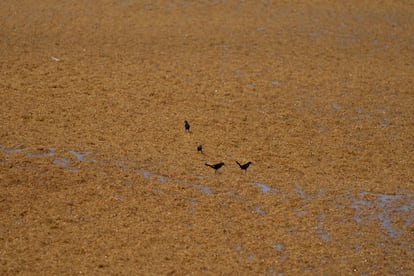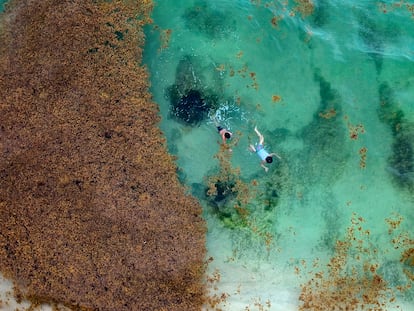A decade of sargassum damage is suffocating Caribbean ecosystems
From Colombia’s north coast to Mexico, corals, mangroves and turtle nests are threatened by the massive influx of floating seaweed

For over 20 years, Mexican biologist María del Carmen García Rivas has been dedicated to protecting the corals of the Yucatán Peninsula in the Caribbean Sea. As the director of Puerto Morelos National Reef Park, she has pushed for changes to reduce water runoff and pollution from coastal development. García has also worked on controlling invasive lionfish, which endangers the 670 species of marine fauna in the park. Since 2018, she’s been leading efforts to restore coral reefs affected by diseases like bleaching. And another worry now keeps her up at nights — the vast sargassum blooms that wash up on the park’s shoreline.

“When sargassum, a floating macroalgae, reaches the coast, it starts decomposing, creating an oxygen-deprived environment that harms various organisms,” said García. “It mostly affects immobile species like certain starfish, sea urchins, seagrasses and corals.”
Huguette Hernández Gómez, Secretary of Ecology and Environment for Quintana Roo, the state where Puerto Morelos National Reef Park is situated, says they cleared the beaches of 70 tons of sargassum in 2023 alone. Over the past four years, they’ve cleared 200 tons.
A regional problem
It’s the same story all across the Caribbean. While small amounts of sargassum benefit marine life, the large blooms since 2011 have disrupted the ecological balance in potentially irreversible ways. The algae further stresses Caribbean reefs already threatened by mass coral bleaching due to climate change. Sargassum patches cover up sea turtle nesting sites and overwhelm mangroves, important nurseries for aquatic species. In some areas, beaches have eroded due to algae removal using heavy machinery, with fishermen noting a significant decline in daily catches.

Because of the significant scale of this fairly recent issue affecting areas from the West African coasts to the Americas, the full extent of the environmental damage it may cause is not well understood. Dr. Brian LaPointe, a biologist and sargassum expert at Florida Atlantic University, said, “We haven’t made much progress in researching the causes, nor in how to deal with the problem and mitigating its effect on the environment.”
World’s second largest barrier reef
García’s observations in Mexico shed light on the implications for the entire region. The park she manages is part of the Mesoamerican Barrier Reef System (MARS), stretching over 600 miles across Mexico, Belize, Guatemala and Honduras. This reef, the second largest in the world after Australia’s Great Barrier Reef, is home to about 500 fish species and 60 stony coral species, according to the World Wide Fund for Nature (WWF). It also supports the livelihood of around two million people in the Caribbean.
While floating sargassum can offer a healthy habitat, large amounts onshore can suffocate specific organisms, says James Foley, oceans manager at The Nature Conservancy. “In places like coastal Belize, the issue gets worse because floating sargassum traps a bunch of marine litter — trash from rivers flowing into the Caribbean from Central America. So, it turns into quite a toxic situation.”
Foley explains that floating sargassum acts as a barrier, blocking light and hindering organisms below from photosynthesizing. A 2021 study in Climate Change Ecology examined three bays in Quintana Roo and found that light filtration drops by up to 73% under floating sargassum patches, and water temperatures can rise by up to 5°C (9°F).
Moreover, García says the bacteria in sargassum could also be affecting corals. “The bacteria that manage to survive in sargassum patches not only affect corals, but also end up causing fish deaths.” García says that the most significant historical damage to corals still stems from coastal development and poor sewage and waste management, but the sargassum is aggravating the situation. “When seawater is polluted, corals can’t really thrive — it weakens them. And if corals get sick or stressed by the heat, they’re more likely to die.”

Dr. Camilo Trench, a marine biologist at the University of the West Indies (UWI) in Jamaica, has raised similar concerns. “The issue is that algae grow rapidly while coral grows slowly. When sargassum is present alongside other macroalgae, it can outgrow the coral reef. This not only limits space for coral growth but also diminishes settlement areas for coral nurseries.”
Other species under threat
Coral is visibly impacted by sargassum, but it’s not alone. A study in Marine Pollution Bulletin looked at the damage caused by a huge sargassum influx on Mexico’s Caribbean coasts in 2018. When all the sargassum decomposed, it clouded the water and led to the death of 78 wildlife species. Most affected were the demersal (bottom feeders) and neritic (coastal or inshore) fish, along with crustaceans.
Other scientists have raised concerns about how sargassum affects turtle nests. In 2017, marine biology professor Briggite Gavio from Colombia’s National University surveyed Cayo Serranilla, a tiny island at the northernmost point of the country’s Caribbean waters. The island’s main inhabitants are a small military contingent and nesting sea turtles.
During Gavio’s scientific field work, 15 inches (40 centimeters) of sargassum covered the beaches. “We were able to observe some baby turtles having trouble passing the barrier posed by the sargassum mat, and were vulnerable to predation by ghost crabs, rats and other predators,” Gavio reported. Scientists from other Caribbean islands like Antigua and Barbuda have reported similar effects of sargassum on sea turtles.

Sargassum also appears to have a potentially lethal impact on Caribbean mangroves, an important natural barrier to hurricanes and nursery for marine life. “These plants live by the seashore and rely on their aerial roots and underground respiratory roots for oxygen,” said Camilo Trench. “Imagine a sargassum mat covering mangrove roots, halting oxygen flow. This may lead to long-term death, similar to an oil spill’s impact.” Like corals, mangroves can end up suffocated and damaged by sargassum, endangering other species that rely on them.
For García, one fact stands out as particularly alarming: unlike other reef issues she deals with, the sargassum problem has no clear solution. “We have not created a virtuous circle like, for example, with the lionfish,” she said. “Despite being an invasive species, [lionfish] can be caught and eaten, which mitigates the problem.”
Last year, the State of Quintana Roo created a committee of 60 experts from different fields who worked for seven months to develop a comprehensive strategy for the management and use of sargassum in the state. The document covers eight main subjects: health, research, monitoring, knowledge management, logistics, utilization, legal framework, economic instruments, and crosscutting issues. One important achievement was appointing Quintana Roo as the authority empowered to grant permits for the productive utilization of sargassum. “The state government issues permits for collection and disposal, streamlining the permit process and avoiding confusion about federal and municipal authority,” said Huguette Hernández.

Combatting sargassum is expensive. The Mexican Navy was allocated $3 million last year to remove sargassum at sea with ships and anchored barriers. Similarly, Mexico’s Federal Maritime Terrestrial Zone was granted $7 million for beach clean-up efforts. In Quintana Roo, an additional $1.7 million was allocated to addressing the problem. “And we’ll spend at least that much this year,” said Hernández.
Sign up for our weekly newsletter to get more English-language news coverage from EL PAÍS USA Edition
Tu suscripción se está usando en otro dispositivo
¿Quieres añadir otro usuario a tu suscripción?
Si continúas leyendo en este dispositivo, no se podrá leer en el otro.
FlechaTu suscripción se está usando en otro dispositivo y solo puedes acceder a EL PAÍS desde un dispositivo a la vez.
Si quieres compartir tu cuenta, cambia tu suscripción a la modalidad Premium, así podrás añadir otro usuario. Cada uno accederá con su propia cuenta de email, lo que os permitirá personalizar vuestra experiencia en EL PAÍS.
¿Tienes una suscripción de empresa? Accede aquí para contratar más cuentas.
En el caso de no saber quién está usando tu cuenta, te recomendamos cambiar tu contraseña aquí.
Si decides continuar compartiendo tu cuenta, este mensaje se mostrará en tu dispositivo y en el de la otra persona que está usando tu cuenta de forma indefinida, afectando a tu experiencia de lectura. Puedes consultar aquí los términos y condiciones de la suscripción digital.










































